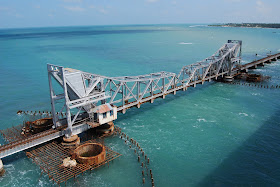Pamban Bridge
The Pamban Bridge (Tamil: பாம்பன்பாலம்)a type of cantilever bridge on the Palk Strait connects Rameswaram on Pamban Island to mainland India. It refers to both the road bridge and the cantilever railway bridge, though primarily it means the latter. It was India's first sea bridge. It is the second longest sea bridge in India (after Bandra-Worli Sea Link) at a length of about 2.3 km.
The railway bridge is 6,776 ft (2,065 m) and was opened for traffic in 1914. The railroad bridge is a still-functioning double-leaf bascule bridge section that can be raised to let ships pass under the bridge.
The railway bridge historically carried meter-gauge trains on it, but Indian Railways upgraded the bridge to carry broad-gauge trains in a project that finished Aug. 12, 2007. Until recently, the two leaves of the bridge were opened manually using levers by workers. About 10 ships — cargo carriers, coast guard ships, fishing vessels and oil tankers — pass through the bridge every month. From the elevated two-lane road bridge, adjoining islands and the parallel rail bridge below can be viewed.
Pamban Bridge
As per chronicles of Kutch Gurjar Kshatriya community, mentioned in their book - Nanji Bapa Ni Nondh Pothi. The erection and construction of Pamban Bridge was done by Mistri Manji Daya Wegad with Lakhu Devji Vegad both of Anjar, Varjang Hirji of Nagalpar and Gangji Narayan of Khedoi. Together built the Railway lines and Pamban Bridge over creek of Rameshwaram to Pamban construction of which they started in year 1887 and completed sometime in 1912 for South Indian Railway. While working on Pamban Bridge the Mistris Lakhu Devji Vegad of Anjar and Gangji Narayan of Khedoi also built famous Temple of Neel-Mandir having seven domes at Rameshwaram, construction which, they started in 1899 and completed in about five years by 1905. After completion of bridge metre-gauge lines were laid by them from Mandapam up to Pamban Staion, from here the railway lines bifurcated into two directions one towards Rameshwaram about 6.25 miles up and another branch line of 15 miles terminating at Dhanushkodi. The section was opened to traffic in 1914.
According to Dr Narayanan, the bridge is located at the "world's second highly corrosive environment", next to Miami, US, making the construction a challenging job. The location is also a cyclone-prone high wind velocity zone. This Bridge consist of 143 pilers and the center span is called swichers bridge. It's 220 ft long and each of 100 tonnes.
Location
The bridge spans a 2 km-strait between mainland and island and is the only surface transport link between the two. The mainland end of the bridge is located at 9°16′56.70″N 79°11′20.1212″ECoordinates: 9°16′56.70″N 79°11′20.1212″E.
 |
| Train track on the sea |
 |
| Center bridge in train track |
 |
| Center bridge |
 |
| see both of bridges |
 |
| see train on the sea |







No comments:
Post a Comment